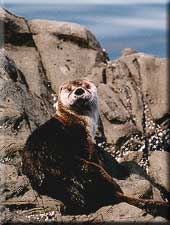
|
The Gulf Islands |
 |
Made up of over a dozen large islands, interspersed with a multitude of islets
too numerous to count, this special west coast of Canada is a small taste of the Mediterranean, blended with a unique Canadian flavour.
The Gulf Islands enjoy less than 30 inches per rain a year.
Lying southwest of the Strait of Georgia, along the coast of Vancouver Island
between Campbell River to the north and Victoria to the south, this necklace
of islands is surrounded by sheltered waters, strong tides, and dramatic coastlines.
|
The long, slender formations are actually the tops of mountains, formed millions of
years ago and now submerged in the sea. The story of the birth of the islands
would be a fascinating TV series, if it could be sped up!
Picture it. Place yourself back one hundred million years ago, when the Coast
Range was located near the edge of the North American continent. Then imagine
the Juan de Fuca Plate, an oceanic plate bearing a huge subcontinent, moving northeast
toward the mountains on a collision course, with nothing to prevent the meeting
of these land masses. |
|
Imagine this tenacious tectonic plate then inching under the edge of the beleaguered
continent, a few inches every year, with no regard for the subcontinent it carried.
Scraped away, this discarded mass forms a huge mound on its own that becomes, amazingly,
Vancouver Island! |
 |
Formation of Vancouver Island
The bedrock of the Coast Range warps and folds under the pressure, as does the newly
formed Vancouver Island. Several large depressions are formed - notably
Nanaimo Basin and Georgia Basin.
Advance time to a mere two million years ago. The Ice Age now pushes ice sheets southward
and the region becomes buried in ice. Deep valleys are carved and the final touches
to this unique topography are added when the glaciers retreat.
|
 |
Primarily sandstone, overlaid in places with fertile till left from the retreat, the
islands are now formed as the ice melts and water refills the low areas, leaving only
the tops of the old shattered basin floors exposed. What was once down is now up!
Perhaps ten thousand years ago, Coast Salish settlements are established. There are
abundant salmon, shellfish, animals, berries and other harvests combining with a mild
climate that encourages permanent and summer camps to form. Many of the characteristic
white shell beaches seen on the islands today are evidence of their middens.
|
History of the Gulf Islands
The Spanish are the first Europeans to arrive, as evidenced by the names of so many of
the islands and waterways in the Gulf Islands. (Valdez, Galiano, Saturna,
Cortes,
to mention a few.)
By 1790, the Spanish are laying claim to much of the area
but Captain George Vancouver is on his way! The British recognize the prime trading
potential of the area and send out James Douglas to establish Fort Victoria and the Hudson's
Bay Company. Wave after wave of settlers arrive soon after, to establish new lives
on the islands. Some are defeated by the difficulties of transportation and isolation
and leave, while others stay and thrive. Many of the old orchards still seen on the
islands bear evidence of the
once thriving fruit growing industry here. Alternately logging, fishing, mining,
canneries and quarries, all rise and fall with the times, as settlers try to eke out a living.
Since the 1850's, the population has slowly increased, with many people retiring to the
gentle climate and community based lifestyle of these laid back islands. The
emphasis now is one the "gentler" industries of tourism, cottage industries and the arts.
|
|
Recent additions to park land by the Pacific Marine Heritage Legacy, have ensured that
large tracts of the the Gulf Islands will always remain pristine sanctuaries for the
birds, animals and marine life that also enjoy the special shores of the Gulf Island.
(Killer whales, Dall and Harbour porpoise, Humpback whale, sea lions, seals, river otters,
mink, raccoons, and several varieties of endangered birds.) The many parks, ranging from
developed to wild, offer the visitor a chance to
enjoy nature, views, wildlife and to experience a special form of relaxation.
|
 |
|